Sagittarius A
October 27, 2014
We're all
suburbanites, since our
Solar System is located in the "
suburbs" of our
Milky Way Galaxy. We're in a region where the average distance between
stars is a few
light years. The nearest star to us,
Proxima Centauri, is 4.24 light years away, which is like
acre zoning. The distance between stars near the
Galactic Center, is only a light week, so the galactic center is like the
city to our suburb.
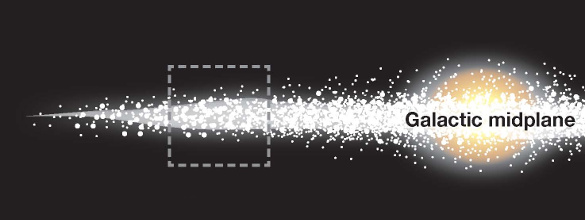
Our Solar System is in the middle of this boxed region. It's a region that's intermediate between the crush of the urban core, and the desolation of the rural rim. In this case, the word, "desolation," can be considered to be a pun, since "sol" is the Latin word for Sun. (Fermi National Laboratory image, simplified.)
Our knowledge of the structure of our
galaxy was limited to the
analogy with the nearby
Andromeda Galaxy until late in the
20th century. Just after
World War II, pioneering
radio observations of the
Doppler shift of the
microwave hydrogen line by
Dutch astronomers,
Hendrik van de Hulst,
Jan Oort and C.A. Muller, elucidated the
spiral structure of the Milky Way. As a student, van de Hulst realized that the microwave signature of
neutral hydrogen at 1420.40575177
MHz (21.10611405413
cm wavelength) could be detected and act as a means to view through the
cosmic dust of the
galactic plane.
One interesting radio feature of the Milky Way is an intense radio source at its center. In fact, this radio source, named
Sagittarius A since it's in the direction of the
constellation,
Sagittarius, was the first
extraterrestrial radio source detected. This discovery, was made by
accident, as are many
scientific discoveries, in 1932 by
Karl Jansky, a physicist at
Bell Laboratories.
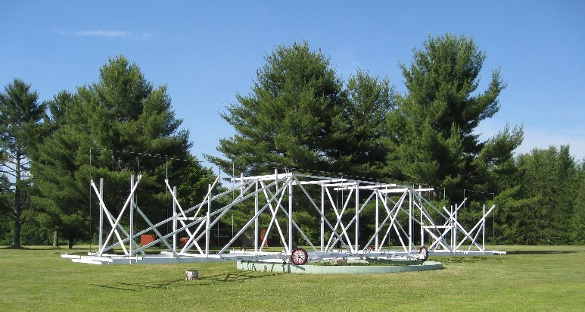
This replica of Jansky's radio telescope is found at the National Radio Astronomy Observatory, Green Bank, West Virginia. Photograph via Wikimedia Commons)
Jansky's specific task was to quantify all sources of
natural radio interference, such as lightning storms. For these observations, he built a highly-directional
antenna to listen at 20.5 MHz (about 14.6
meters wavelength).[2-3] An antenna must have a size comparable to the
signal wavelength, so Jansky's antenna was about 100
feet (30.5 meters) long and 20 feet (6 meters) high, and it was designed to
rotate. Jansky found a radio source whose
period was a
sidereal day, which confirmed its extraterrestrial origin.
Jansky's discovery was front page news in the
May 5, 1933, New York Times, and it reached the
technical literature in the 1933 Proceedings of the
IRE (a founding organization of the
IEEE).[4] To quote from the IRE paper's
abstract,
"Electromagnetic waves of an unknown origin were detected during a series of experiments on atmospherics at high frequencies... the waves come from some source outside the solar system."[4]

The discovery data for Sagittarius A from Jansky's radio telescope. Presuming that the copyright was renewed for the IRE journals, Jansky's paper will not be in the public domain until 2028. It is Wikipedia's position that works consisting entirely of information that is common property and containing no original authorship are in the public domain. (See Wikimedia Commons for one version of these data.)[4)]
Jansky wanted to do a more precise, follow-up study, but his
telephone company employer wasn't interested. The next serious work was done several years later by
electrical engineer and
amateur radio operator,
Grote Reber. From the late 1930s to the end of World War II, Reber was the world's only
radio astronomer. Most agree that Jansky, who died in 1950 at age 44, would have won the
Nobel Prize had he lived a little longer. Two other Bell Labs physicists,
Arno Penzias and
Robert W. Wilson, shared the 1978
Nobel Prize in Physics for their discovery of the
cosmic microwave background radiation.
Jansky's instrument had an
angular resolution of ± 7.5
degrees in one
dimension, and ± 30 degrees in the other, so no details of the galactic center could be seen.[4] Larger
telescopes and
interferometer techniques in much later years showed that the galactic center has three discrete radio emitters. The most intense of these,
Sagittarius A* (abbreviated Sgr A*), is thought to be a
supermassive black hole sited at the center of the galaxy. It is thought that all
spiral galaxies, like our own, and all
elliptical galaxies, have supermassive black holes at their centers.
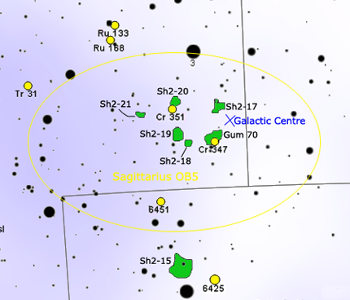
A busy place.
The galactic center is at a far corner of the Sagittarius constellation, whose boundaries are shown.
(Map by Roberto Mura, cropped, via Wikimedia Commons.)
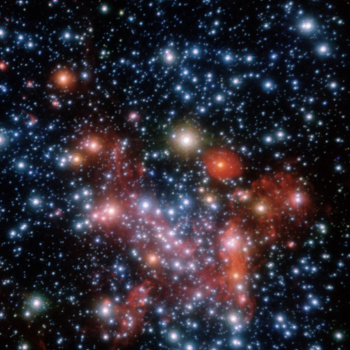
infrared image of Sagittarius-A* at 300 microarcsecond resolution, produced using adaptive optics at the ESO Very Large Telescope array.
(ESO image by Stefan Gillessen, Reinhard Genzel, and Frank Eisenhauer, via Via Wikimedia Commons. See this press release for details.)[5-7]
Astronomers are still trying to see more deeply into the galactic center. A team of astronomers from the
University of California (Santa Barbara, California), the
Lebedev Physical Institute of the
Russian Academy of Sciences (Moscow, Russia), the
Max Planck Institute for Radio Astronomy (Bonn, Germany), and the
Harvard-Smithsonian Center for Astrophysics (Cambridge, Massachusetts), have imaged the galactic center by combining signals from the
Very Long Baseline Array and the
Green Bank Telescope to create a radio interferometer at a 1.3 cm wavelength and a baseline of 3,000
kilometers.[8-10] One object of these studies is to determine whether the flow of
gas is towards, or away from, the supermassive black hole.[10]
The motivation for the study was data obtained with a radio interferometer with a huge baseline of up to 350,000 km formed by the
Russian RadioAstron spacecraft, launched in July, 2011, and various ground-based radio telescopes. Some definite substructure was evident in that data, so the ten identical antennas of the Very Long Baseline Array, distributed across the
United States, and the 100-meter Green Bank Telescope in
Green Bank, West Virginia were used for confirmatory observations. The new data showed the substructure, although the images were extremely faint.[10]
The data show that the emission region is just twenty times the
diameter of the presumed
event horizon of the black hole. The next follow-up would use the proposed
Event Horizon Telescope, a combination of individual telescopes into an interferometer operating at 230-450 GHz.[8-9] Says study
coauthor,
Carl Gwinn of the University of California, Santa Barbara,
"We're also interested in looking at shorter wavelengths... We might possibly be able to make a simple image of how matter falls into a black hole or is ejected from it. It would be very exciting to produce such an image."[10]
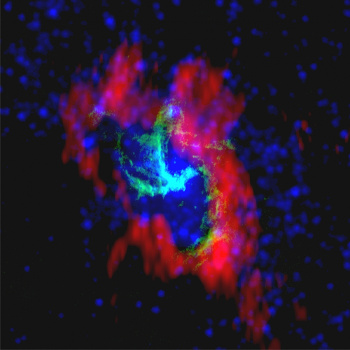
Composite of Sagittarius A* radio images from the NRAO Very Large Array (green), BIMA (red) and the NASA Spitzer Space Telescope (blue).
(NRAO/AUI image, via the University of California, Santa Barbara.)
![]()
References:
- Hugo van Woerden and Richard G. Strom, "The Beginnings of Radio Astronomy on The Netherlands," Journal of Astronomical History and Heritage, vol. 9, no. 1 (2006), pp. 3-20 (PDF File).
- C. M. Jansky, Jr., "My Brother Karl Jansky and His Discovery of Radio Waves from Beyond the Earth." March 23, 1956 (Reprinted in Cosmic Search, vol. 1, no. 4).
- "Karl Jansky and the Discovery of Cosmic Radio Waves," National Radio Astronomy Observatory, May 16, 2008.
- K.G. Jansky, "Electrical Disturbances Apparently of Extraterrestrial Origin," Proceedings of the Institute of Radio Engineers, vol. 21, no. 10 (October, 1933), pp. 1387-1398, DOI: 10.1109/JRPROC.1933.227458.
- S. Gillessen, F. Eisenhauer, S. Trippe, T. Alexander, R. Genzel, F. Martins, and T. Ott, "Monitoring stellar orbits around the Massive Black Hole in the Galactic Center," The Astrophysical Journal, vol. 692, no. 2 (February 20, 2009), pp. 1075ff., doi:10.1088/0004-637X/692/2/1075.
- S. Gillessen, F. Eisenhauer, S. Trippe, T. Alexander, R. Genzel, F. Martins, and T. Ott, "Monitoring stellar orbits around the Massive Black Hole in the Galactic Center," arXiv, October 28, 2008.
- Unprecedented 16-Year Long Study Tracks Stars Orbiting Milky Way Black Hole, European Southern Observatory Press Release No, eso0846, December 10, 2008.
- C.R. Gwinn, Y.Y. Kovalev, M.D. Johnson, and V.A. Soglasnov, "Discovery of Substructure in the Scatter-Broadened Image of Sgr A*," The Astrophysical Journal Letters, vol. 794, no. 1 (October 10, 2014), L14, doi:10.1088/2041-8205/794/1/L14.
- C.R. Gwinn, Y.Y. Kovalev, M.D. Johnson, and V.A. Soglasnov, "Discovery of Substructure in the Scatter-Broadened Image of Sgr A*," arXiv, September 11, 2014.
- Julie Cohen, "Inside the Milky Way - UCSB astrophysicist uses data gathered by a Russian spacecraft to bring science one step closer to figuring out the mysteries of our galaxy’s core," University of California, Santa Barbara, Press Release, October 13, 2014.
Permanent Link to this article
Linked Keywords: Suburb; suburbanite; Solar System; Milky Way Galaxy; star; light year; Proxima Centauri; acre zoning; Galactic Center; city; urban core; desolation; rural; pun; Latin; Sun; Fermi National Laboratory; galaxy; analogy; Andromeda Galaxy; 20th century; World War II; radio astronomy; radio observation; Doppler effect; Doppler shift; microwave; hydrogen line; Dutch; astronomer; Hendrik van de Hulst; Jan Oort; spiral galaxy; spiral structure; neutral hydrogen; hertz; MHz; centimeter; cm; wavelength; cosmic dust; galactic plane; Sagittarius A; constellation; Sagittarius; astronomical radio source; extraterrestrial radio source; serendipity; accident; science; scientific; Karl Guthe Jansky; Bell Labs; Bell Laboratories; National Radio Astronomy Observatory; Green Bank, West Virginia; Wikimedia Commons; nature; natural; electromagnetic interference; radio interference; antenna; meter; signal; foot; feet; rotation; rotate; frequency; period; sidereal time; sidereal day; May 5, 1933, New York Times; scientific literature; technical literature; Institute of Radio Engineers; IRE; Institute of Electrical and Electronics Engineers; IEEE; abstract; data; radio telescope; copyright; public domain; Wikipedia; Wikimedia Commons; Bell System; telephone company; electrical engineering; electrical engineer; amateur radio operator; Grote Reber; radio astronomy; radio astronomer; Nobel Prize; Arno Penzias; Robert W. Wilson; Nobel Prize in Physics; cosmic microwave background radiation; angular resolution; degree; dimension; telescope; interferometry; interferometer; Sagittarius A*; supermassive black hole; spiral galaxy; elliptical galaxy; Sagittarius constellation; infrared; adaptive optics; ESO Very Large Telescope array; European Southern Observatory; ESO; University of California (Santa Barbara, California); Lebedev Physical Institute; Russian Academy of Sciences (Moscow, Russia); Max Planck Institute for Radio Astronomy (Bonn, Germany); Harvard-Smithsonian Center for Astrophysics (Cambridge, Massachusetts); Very Long Baseline Array; Green Bank Telescope; kilometer; gas; Russia; Russian; Spektr-R; RadioAstron; spacecraft; United States; Green Bank, West Virginia; diameter; event horizon; Event Horizon Telescope; collaborative writing; coauthor; Carl Gwinn; photomontage; composite; National Radio Astronomy Observatory; NRAO; Berkeley-Illinois-Maryland Association; BIMA; NASA Spitzer Space Telescope.